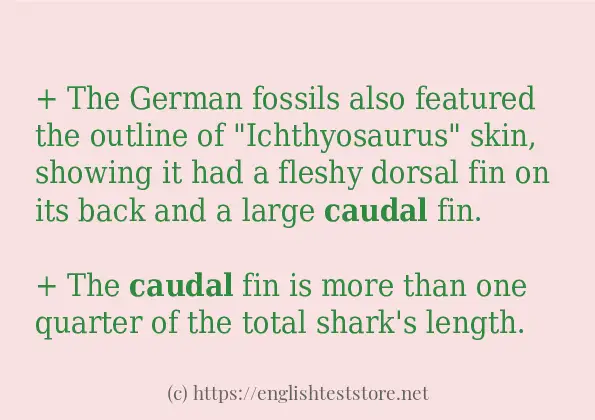How to use in-sentence of “caudal”:
+ The German fossils also featured the outline of “Ichthyosaurus” skin, showing it had a fleshy dorsal fin on its back and a large caudal fin.
+ The caudal fin is more than one quarter of the total shark’s length.
+ Its large size and extended gill slits which nearly encircle the head and caudal fin together, helps distinguish it from all other species.
+ One the caudal fin, there is no notch on the upper lobe and the lower lobe is not well-developed.
+ This species has a whitish-tipped first dorsal, pectoral fins, pelvic fins, and caudal fin.
+ The Galapagos shark has been reported to display threat behaviors including arching of the back, raising the head, and lowering the caudal and pectoral fins while swimming in a twisted, rolling motion.
+ There is also an anal fin, which is also considered spiny, and a caudal fin.
+ Although both shark species have white markings on the dorsal and caudal fins, the whitetip reef shark doesn’t have these markings on the tips of the pectoral fins.

Example sentences of “caudal”:
+ Not all sharks have anal fins, but if they do have them, they are found between the pelvic and caudal fins.
+ The tail region itself consists of the caudal peduncle and the caudal fin.
+ Not all sharks have anal fins, but if they do have them, they are found between the pelvic and caudal fins.
+ The tail region itself consists of the caudal peduncle and the caudal fin.
+ This unusual fish swims by flapping its long pectoral and dorsal fins; the caudal fin is used as a rudder.
+ The caudal peduncle sometimes has notches known as “precaudal pits”, which are found just ahead of the caudal fin.
+ The strong, non-lunate caudal fin in most benthic zonebenthic shark species allows the shark to swim close to the seabed.
+ However, when confronted by divers, the Blacknose shark has been reported to give a threat display in the form of a hunched back with head raised and caudal lowered.
+ The edges of the dorsal fins and the caudal fin have a dusky-colour at birth, but this colour quickly fades.
+ The whitetip reef shark gets its name because of the white tips on its first dorsal fin and caudal fin.
+ The silvertip shark may be confused with the grey reef shark, but the grey reef shark has dark tips on the pectoral fins and trailing edge of the caudal fin.
+ Ghanim Al Muftah is a Qatar-born entrepreneur, motivational speaker, a social media celebrity, and a philanthropist, born in Qatar with Caudal regression syndromeCaudal Regression Syndrome.
+ The upper lobe of the caudal fin produces the most amount of the push, and usually forces the shark downwards.
+ Recovering missing data: estimating position and size of caudal vertebrae in “Staurikosaurus pricei” Colbert, 1970.
+ The caudal fin has both, an upper lobe, and a lower lobe, that can be of different sizes and the shape depends of which species the shark is.
+ However, the fastest swimming sharks caudal fins.
